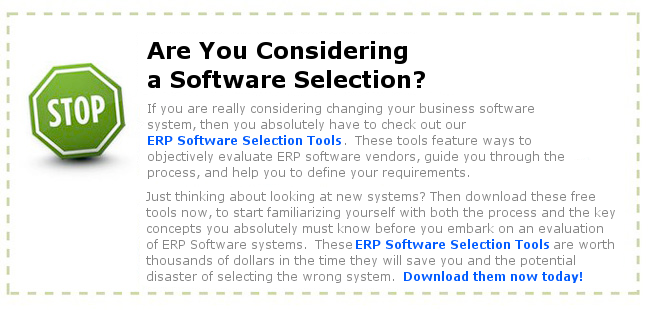ERP Manufacturing Software is a specific category of ERP Software and one that can be confusing. There a multitude of ERP Manufacturing Software vendors in the market, but which one is the best one for you? The simple answer is that there may be several. There are at least four key factors that need to be examined when selecting ERP manufacturing software.
The first is the industry you are working in. Are you a process manufacturer, such as paint or chemicals? Or, are you a discrete manufacturer making specific parts? More specifically, do you make repetitive parts, or are the parts make to order? Are you a job shop environment, estimating and making parts to order? Or are you a project based manufacturer, that similar to a job shop estimates and makes parts to order, but because of a complex process or a lengthy time for manufacturing makes parts as part of an overall project? There are specific software types for each of these manufacturing industries. The key to honing in on the specific manufacturing ERP solution is to know your industry type and then examine software that serves that industry.
Which leads us to the second point, the ERP manufacturing software’s legacy. Where did this software evolve from? What industry did it originally serve and what industries were added. A software that was built around a particular industry usually has that industries best practices built into the software functionality. When the software expands to other industries, it doesn’t always fit the best practices of that secondary industry as well. And many softwares become “jack of all trades, but master of none.” Look into where the ERP software evolved from.
Once you understand the legacy of the ERP manufacturing software, you need to look at its process functionality. This means that you should have some specific case examples of your process and have the vendor demonstrate that there ERP software can handle your process flow. You do not need to do some extensive flowcharting and spend months on the design. Simply understand the flow of orders in your plant and have the system replicate that flow for you, using your data. The vendor should be able to show you this in a “scripted demonstration”. Have them prove to you that it can handle the task at hand.
Lastly, make sure that your ERP manufacturing software vendor has a good fit to your requirements. There are a lot of requirements that a manufacturing software must address, but drill down on the specific requirements that make your organization unique. Is it the way that you account for your inventory? Is it the uniqueness of the bill-of-material structures? Is it a certain process that you employee to produce parts? Give the vendor a listing of your key requirements and using the process demonstration approach have them show you that they can handle these requirements.
There are a lot of factors that you need to consider when selecting an ERP Manufacturing software system. Keep in mind that every software is unique in its approach. They say that they conform to APICS standards, but exactly how they get there is often different. Ensure that you apply enough planning and due diligence to your selection process to extract the deep and sometimes difficult answers to your questions from the ERP vendors. Most of all, keep in mind that there is a lot of smoke and mirrors around the demonstration of ERP software and you need to watch the details for the truth.
